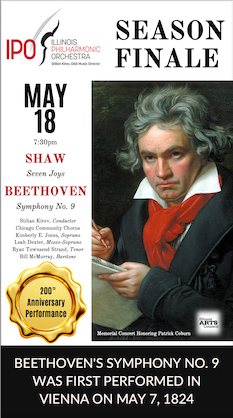Haydn provides the highlight in IPO’s classical-era program

Stilian Kirov conducted the Illinois Philharmonic Orchestra Saturday night at Trinity Christian College in Palos Heights. Photo: Chuck Moses
After a very American season to date, the Illinois Philharmonic Orchestra and its music director, Stilian Kirov, returned to 18th-century Europe Saturday night at Trinity Christian College.
The one exception to the above was the concert’s opener, the world premiere of no last days, only more tomorrows by the IPO’s composer-in-residence, Oswald Huynh.
Huynh has an ear for arresting timbres and textures: from the rustling opening and glassy-toned sawing figures passing among string soli, to slightly out-of-sync repeating figures near the middle, building to acrescendolike a jet taking off.
While the sections were creative and ear-catching—due in no small part to the variation in string tone Kirov coaxed from the orchestra—the piece felt like an episodic succession of these textures, rather than any sort of cohesive whole.
The rest of the program took us to the world of Mozart, Joseph Haydn, and Boulogne (also known as the Chevalier Saint-Georges).
Boulogne—the first prominent European composer of African descent—was represented by his Symphony No. 1, first published in 1779. Like many symphonies of this era, its outer movements are driven by modules, not melodies.
Without melodies at his disposal, Kirov relied on deft handling of dynamics to sustain interest. In the first movement, this took the form of well-controlled forte/piano contrasts in the transition and a nice buildup to the closing theme. In the finale, this included a genuinely suspenseful development.
The only letdown in the performance came in the second movement where the string tone was too wiry, and the articulation and phrasing insufficiently varied.
Mozart was represented by his Horn Concerto No. 4, the last and most played of his concerti for the instrument, with Lee Shirer, IPO’s principal hornist, as soloist.

Shirer’s rendition of the solo part was clean and technically secure. But perhaps to balance with a small orchestra, he played with a subdued and, at times, woolly tone throughout all three movements, with little of the sprightliness one expects in this music.
And although his phrasing was suitably lyrical in the Romanze, he occasionally lagged behind the orchestra, both there and in the finale. Kirov did his best to adjust to his soloist, and was a sympathetic accompanist throughout.
As an offbeat encore, Shirer sang Flanders & Swann’s “Ill Wind”—a humorous song set to the concerto’s finale, in which an amateur hornist bemoans the theft of this horn. He displayed excellent comic timing throughout, especially with his teasing pauses in the deliberately drawn-out cadenza.
The last work of the evening provided the strongest performance with Haydn’s Symphony No. 104 (his last), nicknamed “London.”
The one oddly interpreted movement was the minuet. The sforzandi were underplayed (something that was not a problem anywhere else in the symphony). And the trio had as much rubato as one expects in Tchaikovsky, not Haydn. Nonetheless, the orchestra played with an irrepressible joie de vivre that fit the movement’s overall mood.
The outer movements proved ideal. The introduction to the first movement had real bite and the development sections in both movements crackled with drama. Kirov brought out the changes in orchestration Haydn makes between his expositions and recapitulations, with colorful contributions from the IPO’s flutes, oboes, and horns.
Aside from a slightly awkward retransition, the second movement went splendidly too, with a playfully phrased main theme and an impassioned, stormy middle section.
The IPO’s season continues 6:30 p.m. April 16 at Prairie State College, with a program called “Classical Evolves,” workshopping new pieces by Daixuan Ai, Chris Neiner, Osnat Netzer, and Sepehr Pirasteh. ipo-music.my.salesforce-sites.com
Posted in Performances




Posted Apr 15, 2024 at 9:26 pm by Libby
While I appreciate many of the comments made of the IPO and musicians in regard to the performance last Saturday, I must respectfully disagree with the summary of the Mozart in particular. The IPO audience in attendance Saturday night was overwhelmingly thrilled with a depth and beauty of the horn Concerto and enthusiastically tickled at the Flanders and Swan encore. I’m not aware of any other hornist capable of pulling off a convincing performance of both of these works as well as he, and in the same program nonetheless.
Having spoken with the soloist about his phrasing choices, he explained that one of his musical goals was to have a light Classical European feel as opposed to a more typical American rendition. I personally thought his sensitivity of phrasing was exceptional in all three movements. His purity of sound is rich and warm and has been compared favorably to Frank Brouk and Phil Farkas of CSO folklore.
His cadenza in the first movement was flawlessly executed, despite including some tasteful and treacherous multi-phonics (quite a surprise to an ear expecting the predictable). The last phrase of the credenza was a reworking of the great Dennis brain credenza, his first horn hero.